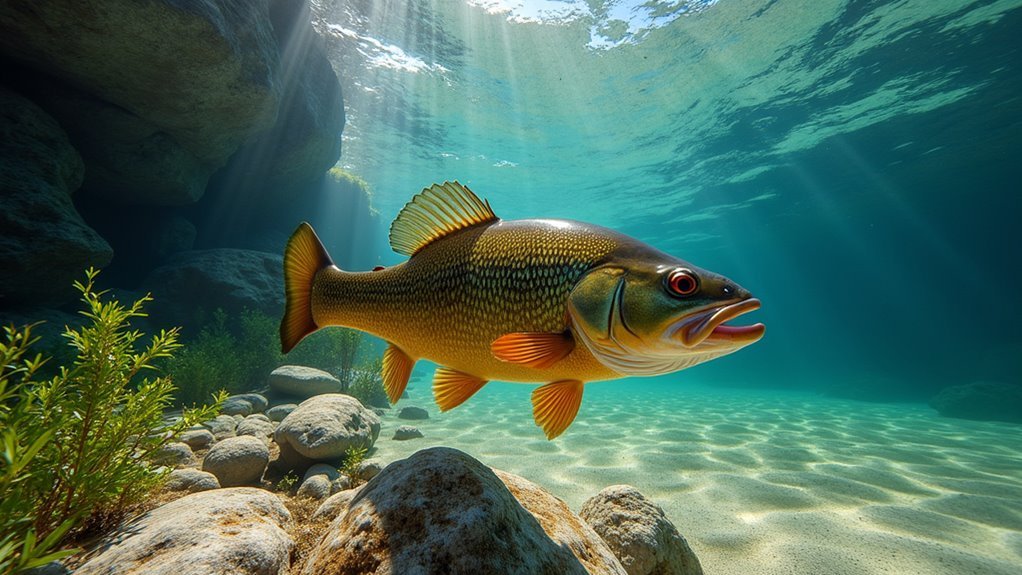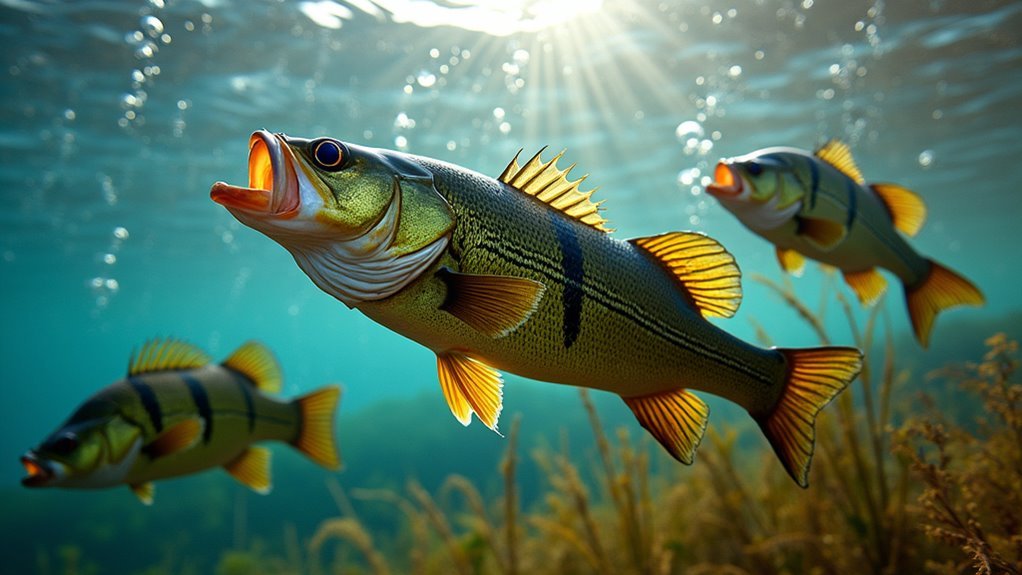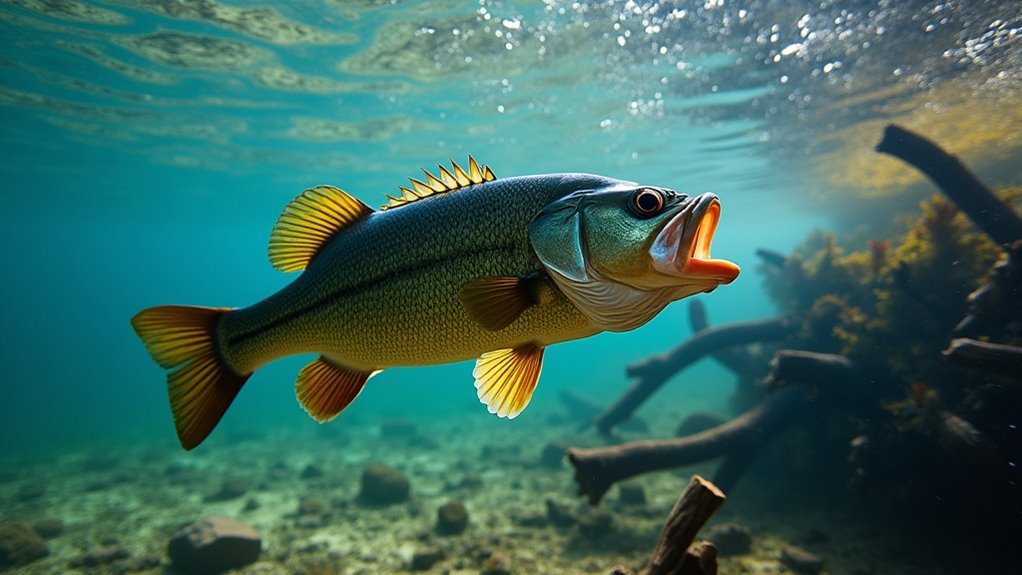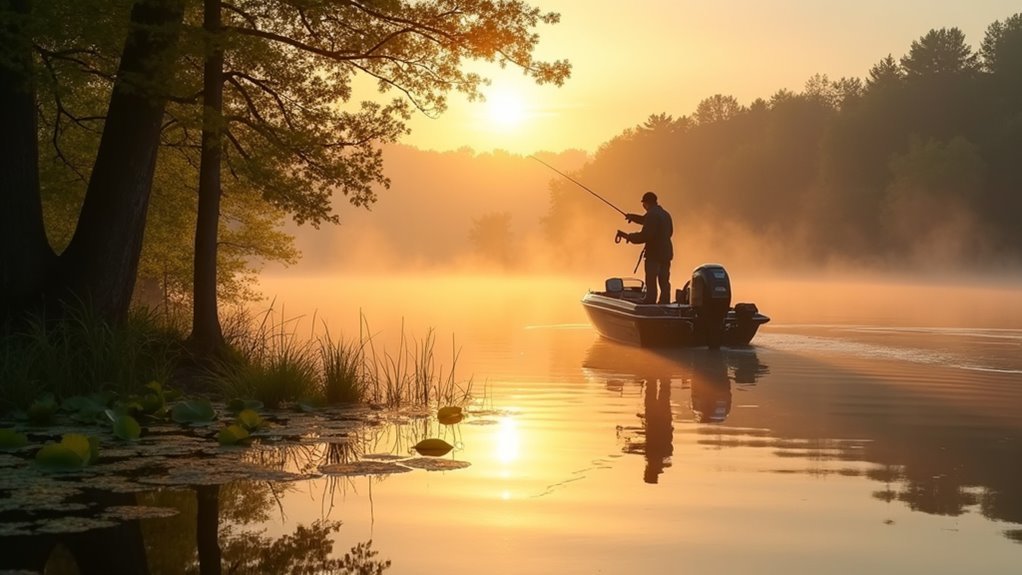We’ll help you master both bass species by learning their key differences. Largemouths have jaws extending past their eyes and prefer murky, vegetated waters, while spotted bass have rough tongue patches and thrive in clear, rocky areas. Your approach should shift seasonally – target spots year-round (especially in winter) and largemouths during warmer months. Equip yourself with medium-action rods, 8-12 lb line, and the right soft plastics to dramatically boost your success on the water.
Spotting the Difference: Visual Keys to Bass Identification

Confusion on the water can turn a perfect fishing day into a head-scratching puzzle. We’ve all been there, staring down at a bass wondering exactly what we’ve caught. Let’s clear it up!
Look first at the jaw – largemouth jaws extend past the eye, while spotted bass don’t reach that far. Check the tongue too; spotted bass have a rough patch you can feel, while largemouth tongues are smooth.
Notice those scales? On spotted bass, cheek scales are smaller than body scales. And don’t miss that belly – largemouths sport a puffy white underside while spotted bass have those telltale dark spots continuing underneath.
Habitat Hunters: Where to Find Each Bass Species

Where do these elusive bass species hide out when they’re not striking our lures? After decades on the water, I’ve noticed these fish have strong habitat preferences that can make or break your day.
- Largemouth bass thrive in murky waters with plenty of vegetation – we’ve caught monsters hiding under lily pads during summer afternoons
- Spotted bass prefer clear water with minimal plant life – typically in reservoirs where they suspend in open water
- Largemouths slow down in winter, while spots stay active year-round
- Rocky structures near dams are spotted bass magnets, while largemouths love those vegetation-rich runoff areas
The Family Tree: Understanding Bass Subspecies

While most anglers focus solely on catching the biggest bass possible, understanding the family branches of these popular gamefish can actually improve your success on the water.
Spotted bass come in three flavors: Northern, Alabama, and Wichita varieties. The Northern is the oldest type, adapting as it moved southward. Largemouth bass break into just two camps: Northern and Florida subspecies. Those Florida largemouth grow faster and sport smaller scales thanks to warmer waters.
I’ve caught both Florida and Northern largemouth, and let me tell you—knowing which you’re after makes all the difference in your approach!
Behavioral Patterns: How Bass Movement Affects Your Approach

If you’ve ever felt frustrated when bass suddenly disappear from your favorite fishing spot, understanding their movement patterns can turn your luck around. We’ve all been there, casting where fish were biting yesterday only to find they’ve moved on today.
- Spotted bass roam and school in open water, rarely establishing a home base
- Largemouth bass stick close to structures like vegetation and fallen trees
- Spotted bass remain active year-round, while largemouth slow down in winter
- Weather fronts trigger movement – we once caught a limit after a storm passed!
Seasonal Strategies: When to Target Each Bass Type

Knowing when to target each bass species throughout the year can dramatically boost your catch rate and save you from wasting hours in unproductive waters. We’ve found that spotted bass remain active year-round, making them excellent targets even during colder months when largemouth slow down.
For largemouths, focus on warm water periods, especially late spring after the spawn when they’re aggressively feeding. I once filled my livewell during a May morning when the water hit 68°F!
Meanwhile, fall is prime time for spotted bass as they hold to structure longer and dive deeper, making them easier to locate with depth finders.
Tackle Talk: Essential Gear for Largemouth and Spotted Success
Having the right gear can make the difference between a frustrating day and a cooler full of bass. We’ve learned this lesson the hard way over years on the water.
Preparation is everything in bass fishing. The tools you bring determine your fortune long before you cast a line.
For both spotted and largemouth success, here’s what you’ll need:
- Medium-action spinning rod with 8-12 lb line (fluorocarbon for spots)
- Soft plastics (Senkos for largemouth, drop shots for spots)
- Depth finder for locating suspended spots and largemouth haunts
- Extra tackle box with various lures for changing conditions
Additionally, understanding trolling motor positioning will significantly enhance your ability to navigate and fish effectively in different environments.
Frequently Asked Questions
Do Bass Remember Being Caught and Avoid Similar Lures Afterward?
We believe bass can remember being caught for a few weeks. They’ll often avoid similar lures afterward, so we recommend varying our presentations when fishing heavily pressured waters.
Can Spotted and Largemouth Bass Interbreed in the Wild?
Ever seen two closely related species mingling in the wild? Yes, spotted and largemouth bass can interbreed, creating viable hybrids. We’ll often find these mixed offspring in waters where both parent species naturally coexist.
How Do Catch-And-Release Handling Techniques Differ Between Species?
We handle both species similarly during catch-and-release, but spotted bass are more sensitive to stress. We’ll want to minimize air exposure and handle them more gently than the hardier largemouth bass.
What Predators Threaten Adult Bass in Their Natural Habitats?
We’ve encountered a silent threat lurking in the waters. Adult bass face predation from larger fish like pike and muskie, birds of prey including ospreys and herons, and sometimes otters and alligators in southern waters.
Do Spotted and Largemouth Bass Taste Different When Prepared?
We’ve found that spotted and largemouth bass taste slightly different. Spotted bass generally offer a cleaner, less muddy flavor, while largemouths can taste earthier depending on their habitat.
Conclusion
We’ve armed you with bass secrets that’ll transform your fishing game forever! With our expert tips on spotting differences, understanding habitats, and choosing the perfect lures, you’ll haul in monsters that’ll make your fishing buddies’ jaws drop to the dock. Remember when we landed that 10-pounder last summer? That could be you tomorrow! Now get out there—those trophy largemouth and spotted bass are practically jumping into your boat already!